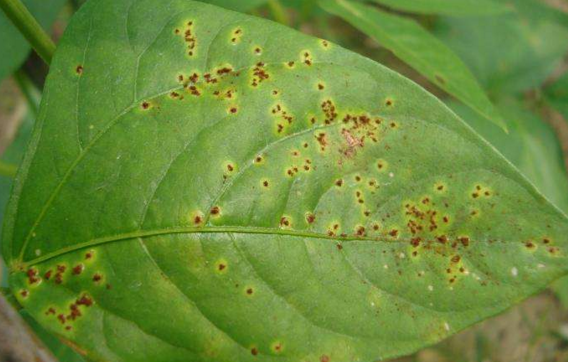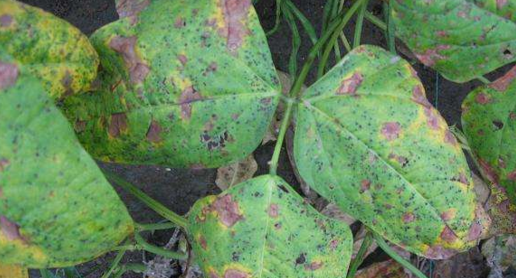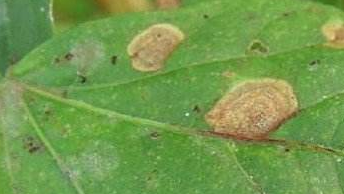Diagnosis and prevention of common diseases of cowpea in greenhouse
Rust
Symptoms: Rust is mainly harmful to the leaves, and in severe cases, all parts of the ground can be harmed. At the beginning of the onset, a yellowish green plaque occurred, which turned into a rust brown bulge. The summer spores are reddish-brown, and red rust-colored urediospores are scattered after the rupture. In the late stage of the disease, stems, petioles, leaves, and pods all produce dark brown rust-like streaks, and the stems and leaves die early, and the pods are inedible.

Control method:
(1) Selection of resistant varieties: Common resistant varieties include Dayeqing, Hongzui Jinshan, and iron green beans.
(2) Reduce the air humidity in the greenhouse, enhance the light: pay attention to ventilation and ventilation, reasonable close planting, can also be covered with plastic film, dark irrigation under the membrane, drip irrigation, reduce humidity, ensure that the leaves do not condense and no water droplets.
(3) Carry out the rotation: carry out the rotation for 2 to 4 years and pay attention to the removal of the centralized treatment of the sick body.
(4) Chemical control: in the early stage of the disease, spray 25% of the powder rust WP 2,000 times solution, or 15% of the triazolone WP 1000-1500 times, or mix drugs, such as 70% mancozeb wettability Powder 2000 times solution, or 25% enemies de-emulsion 4000 times solution plus 15% triazolone wettable powder 2000 times solution. Spray once every 10 days for 2 to 3 times.
Viral disease
Symptoms: Cowpea virus disease manifests systemic symptoms. The leaves appear deep and shallow, sometimes chlorophyll is aggregated, and dark green bands are formed along the veins. Some leaves are deformed, curled, and wilted. The diseased leaves are generally small, and plant growth is inhibited. When the whole plant died.
Control method:
(1) Selection of disease-resistant varieties such as Hongzuiyan and Xinjiang No.8.
(2) Establish a disease-free seed and choose a disease-free plant to keep the seed.
(3) Strengthen cultivation management to remove sick bodies in time, reduce juice transmission, and improve disease resistance of plants.
(4) Early prevention of aphids with 50% dichlorvos emulsion 1000 times solution or spray with imidacloprid.
(5) spraying control at the beginning of the onset of spraying 1.50% phytopathogenic emulsion 1000 times solution or 83 antibacterial agent 100 times solution, once every 10 days or so, for 2 to 3 times, with passivation control.
Coal mold
Symptoms: The disease is mainly manifested on the leaves. On the initial leaves, red to purple-brown dots are formed on both sides, and then enlarged to near-circular or polygonal spots with a diameter of 0.50 to 2 cm, and the junction of the diseased and healthy parts is not obvious. When the humidity is high, the surface of the lesion has a soot-like gray black mold layer, which is obvious on the back of the leaf. In severe cases, the early leaves are left at the top.

Control method:
(1) Removal of the diseased body: The diseased leaves are removed in time at the beginning of the disease, and the diseased bodies are removed in time for treatment and deep-cut.
(2) Strengthening cultivation management: the shed is covered with plastic film; reasonable close planting makes the field ventilate and light; timely ventilation and ventilation to reduce the humidity in the field. Increase the application of phosphorus and potassium fertilizer to improve the disease resistance of plants.
(3) Chemical control: spray 25% carbendazim WP 400 times solution, or 40% polysulfur suspension 800 times solution, or 77% can kill WP 1500 times, or 14% ammonia Copper water agent 300 times liquid, spray liquid 50-60 ml per acre, once every 10 days, even spray 2 to 3 times.
Ring disease
Symptoms: The disease is thought to be harmful to the leaves, but also to stems and pods. The leaves are damaged by the initial thick purple spots, and then enlarged to a diameter of 4 to 8 mm. The circular spots have obvious wheel patterns on the front, and there are sparse dark molds when wet. The stem is damaged, the primary brown is not shaped strips, and then spread around the stem, causing the upper end to die. The fruit pods often form scalloped to purple-brown scalloped lesions.

Control method:
(1) Rotation and non-legume crops are rotated for 2 to 3 years.
(2) Select disease-free seeds from the disease-free land.
(3) Seed disinfection can be soaked in warm water at 45 ° C for 15 minutes, and then cooled and cooled with cold water. It can also be seeded with 50% carbendazim WP, which is 30% of the weight of the seed, or soaked in 40% formalin 200 times for 30 minutes.
(4) Strengthen the cultivation and management of the shed indoor soil should be deep 20 to 30 cm, increase the application of potassium fertilizer, rational close planting, avoid flooding, strengthen ventilation and dehumidification, prevent water droplets from splashing and foliar condensation. Pay attention to the destruction of sick bodies.
(5) In the early stage of the disease prevention and treatment, spray with the following drugs, or 77% can kill 500 times of wettable powder, or 70% of methyl thiophanate WP 1000 times, 7 to 10 days, even spray 2 ~3 times.
Foam Dressing,Soft Elastic Waterproof Foam Dressing,Breathable Foam Dressing,High Absorbency Trauma Foam Dressing
Zhende Medical Co.,Ltd , https://www.zdmedicalproduct.com